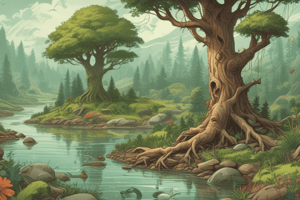Podcast
Questions and Answers
What is a predator?
What is a predator?
Organism that hunts its food, feeds on prey.
What is prey?
What is prey?
The organism that is hunted and eaten.
What does symbiosis mean?
What does symbiosis mean?
Close, long-term interaction between two species in an ecosystem.
What is mutualism?
What is mutualism?
What is commensalism?
What is commensalism?
What is parasitism?
What is parasitism?
What is competition in an ecosystem?
What is competition in an ecosystem?
What is resource partitioning?
What is resource partitioning?
What are biomes?
What are biomes?
Describe a Taiga (Boreal Forest).
Describe a Taiga (Boreal Forest).
What is a temperate rainforest?
What is a temperate rainforest?
What characterizes a temperate seasonal forest?
What characterizes a temperate seasonal forest?
What are tropical rainforests noted for?
What are tropical rainforests noted for?
Describe Shrubland (Chaparral).
Describe Shrubland (Chaparral).
What defines a temperate grassland?
What defines a temperate grassland?
What is a savanna?
What is a savanna?
What is a desert?
What is a desert?
Describe the tundra.
Describe the tundra.
What is photosynthesis?
What is photosynthesis?
What is cellular respiration?
What is cellular respiration?
What is a carbon reservoir?
What is a carbon reservoir?
What is the carbon cycle?
What is the carbon cycle?
What is nitrogen fixation?
What is nitrogen fixation?
What is the atmosphere in terms of nitrogen?
What is the atmosphere in terms of nitrogen?
What is the phosphorus cycle?
What is the phosphorus cycle?
What role does phosphorus play in ecosystems?
What role does phosphorus play in ecosystems?
What is the hydrologic cycle?
What is the hydrologic cycle?
What is the ocean's role in the hydrologic cycle?
What is the ocean's role in the hydrologic cycle?
What is primary productivity?
What is primary productivity?
What is gross primary productivity?
What is gross primary productivity?
What is net primary productivity?
What is net primary productivity?
What does Kcal/m2/yr measure?
What does Kcal/m2/yr measure?
What is red light in aquatic environments?
What is red light in aquatic environments?
What is blue light in relation to water?
What is blue light in relation to water?
What is the 10% rule in ecology?
What is the 10% rule in ecology?
What does the law of thermodynamics state?
What does the law of thermodynamics state?
What is a food web?
What is a food web?
What is temporal partitioning?
What is temporal partitioning?
What is spatial partitioning?
What is spatial partitioning?
What is morphological partitioning?
What is morphological partitioning?
Study Notes
Terminology in Ecology
- Predator: Organism that hunts and feeds on prey.
- Prey: Organism that is hunted and consumed by predators.
- Symbiosis: Long-term interaction between two species in an ecosystem.
Types of Symbiosis
- Mutualism: A symbiotic relationship where both organisms benefit.
- Commensalism: One species benefits while the other is neither helped nor harmed.
- Parasitism: One species benefits at the expense of the other.
Ecological Interactions
- Competition: Occurs within or between species when resources are limited.
- Resource Partitioning: Coexisting species divide resources in time, space, or method to minimize competition.
Biomes Overview
- Biomes: Regional ecosystems characterized by climate, soil conditions, and biological communities.
- Taiga (Boreal Forest): Short growing season, poor soil quality, low biodiversity; dominated by conifers and specific fauna.
- Temperate Rainforest: Coastal biome with moderate temperatures and high precipitation.
- Temperate Seasonal Forest: Characterized by warmer summers, colder winters, and dominated by deciduous trees.
- Tropical Rainforest: Abundant rainfall (>200 cm annually) with poor soil due to leaching; diverse canopy life.
- Shrubland (Chaparral): Found in Mediterranean climates; hot summers, mild, rainy winters with fire-tolerant shrubs.
- Temperate Grassland: Biome with deep, nutrient-rich soils supporting diverse grass species.
- Savanna: Grassy plains in tropical regions, characterized by few trees.
- Desert: Extremely dry regions with scarce plants and low water availability.
- Tundra: Flat, treeless Arctic regions with permanently frozen subsoil.
Key Biological Processes
- Photosynthesis: Plants convert sunlight, water, and carbon dioxide into sugars.
- Cellular Respiration: Releases energy by breaking down glucose in the presence of oxygen.
Carbon and Nitrogen Cycles
- Carbon Reservoir: Key reservoirs include the atmosphere, oceans, and sediments; influenced by combustion of fossil fuels.
- Nitrogen Fixation: Atmospheric nitrogen is converted to ammonia by bacteria or lightning, making it accessible to plants.
- Phosphorus Cycle: Lacks a gaseous phase; main reservoir in rocks and sediment, serves as a limiting factor in aquatic ecosystems.
Water Cycle and Energy
- Hydrologic Cycle: Powered by solar energy, also known as the water cycle.
- Ocean: Major reservoir of water on Earth’s surface.
- Primary Productivity: Rate at which solar energy is converted into organic compounds during photosynthesis.
- Gross Primary Productivity (GPP): Total solar energy captured by producers.
- Net Primary Productivity (NPP): Rate of biomass accumulation after accounting for energy lost in respiration.
Energy Transfer and Trophic Levels
- Kcal/m2/yr: Measurement unit for productivity.
- Energy Transfer: Only 10% of energy is available for the next trophic level, due to energy loss at each stage.
- Law of Thermodynamics: Energy cannot be created or destroyed, only transformed; explains energy loss across trophic levels.
Food Relationships
- Food Web: A complex network of interrelated food chains within a community.
- Temporal Partitioning: Resource competition is reduced by species utilizing resources at different times.
- Spatial Partitioning: Competing species occupy different habitats or areas to use the same resource.
- Morphological Partitioning: Species adapt body forms to exploit different resources effectively.
Studying That Suits You
Use AI to generate personalized quizzes and flashcards to suit your learning preferences.
Description
Explore key terms from AP Environmental Science Unit 1 with these flashcards. Learn about vital concepts such as predator, prey, and different types of symbiotic relationships. Enhance your understanding of ecosystems and interactions between species.




